Carigara
Carigara (Tagalog: [kɐɾiˈɡaɾɐʔ]), officially the Municipality of Carigara (Waray: Bungto han Carigara; Tagalog: Bayan ng Carigara), is a 2nd class municipality in the province of Leyte, Philippines. According to the 2020 census, it has a population of 54,656 people.[3]
Carigara | |
|---|---|
| Municipality of Carigara | |
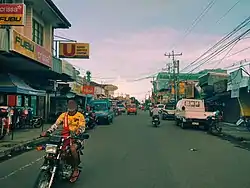 Downtown Area (Real St.) | |
 Flag  Seal | |
| Etymology: Kan Gara to Kalgara | |
 Map of Leyte with Carigara highlighted | |
OpenStreetMap | |
.svg.png.webp) Carigara Location within the Philippines | |
| Coordinates: 11°18′N 124°41′E | |
| Country | Philippines |
| Region | Eastern Visayas |
| Province | Leyte |
| District | 2nd district |
| Founded | 25 January 1571 |
| Named for | Datu Gara |
| Barangays | 49 (see Barangays) |
| Government | |
| • Type | Sangguniang Bayan |
| • Mayor | Eduardo "Ed" T. Ong Jr. |
| • Vice Mayor | Jimmy A. Camposano |
| • Representative | Lolita T. Javier |
| • Councilors | List |
| • Electorate | 38,606 voters (2022) |
| Area | |
| • Total | 117.86 km2 (45.51 sq mi) |
| Elevation | 130 m (430 ft) |
| Highest elevation | 1,267 m (4,157 ft) |
| Lowest elevation | 0 m (0 ft) |
| Population (2020 census)[3] | |
| • Total | 54,656 |
| • Density | 460/km2 (1,200/sq mi) |
| • Households | 12,830 |
| Demonym(s) | Carigaran-on Kalgaran-on (vernacular term) |
| Economy | |
| • Income class | 2nd municipal income class |
| • Poverty incidence | 25.00 |
| • Revenue | ₱ 192.2 million (2020) |
| • Assets | ₱ 606.1 million (2020) |
| • Expenditure | ₱ 156.6 million (2020) |
| • Liabilities | ₱ 160.8 million (2020) |
| Service provider | |
| • Electricity | Leyte 3 Electric Cooperative (LEYECO 3) |
| • Water | Metro Carigara Water District (MCWD) |
| • Telecommunications | Bayan Telecommunications, Globe Telecom, Smart Communications, Dito Telecommunity |
| • Cable TV | G Sat, Sky Direct, Cignal, SatLite |
| Time zone | UTC+8 (PST) |
| ZIP code | 6529 |
| PSGC | |
| IDD : area code | +63 (0)53 |
| Native languages | Waray Tagalog |
| Major Religion | |
| Local Feast | Magara Festival |
| Feast Date | every 25th day of January |
| Website | www |
The town, founded in 1571, is the first town established in the entire region of Eastern Visayas. In 1735, Leyte and Samar were separated from Cebu and placed under a single provincial government with Carigara as the first provincial capital.
Carigara is known for its pastillas, humba, sundang (machete), and the hubhob, a local delicacy made from grated cassava, egg, kalamay, milk, and sugar cooked inside a bagacay (bamboo pole) over charcoals.
History

Carigara was originally called "Kan Gara", meaning "that of Gara" or simply "Gara's." Gara was said to have come from Borneo, one of the unnamed companions of the ten datus who landed in Panay and purchased that island from the Ati (or Aeta) chief Marikudo. Later, for phonetic convenience, "Kan Gara" became Kalgara and when the Spaniards came, they called the place Carigara; hence its present name.

Carigara is the first town established in Eastern Visayas.[5] Its town fiesta which is celebrated every 16 July, commemorates the day of the first coming of the Spaniards dated July 16, 1569. The fiesta that is celebrated almost the entire month of July was dubbed as the Fiesta of the Holy Cross.
In the first quarter of 2018, Puregold was able to penetrate the town market and became operational to serve Carigaran-ons and the neighboring towns. The first mall opened as well, then followed by Goldilocks in the second quarter of 2019.
Carigara's Attempt for a World Record

Last July 14, 2018, Carigara attempted to clinch Guinness World Records for the "Largest Participants in Philippine Folk Dance" by performing Kuratsa or Curacha.[6] The event was part of the town's 423rd fiesta celebration on July 16, it made the locals proud and hopeful that the said event will help to boost their town's economic and tourism activities. With nearly 5,000 participants mostly students and teachers from different schools, municipal workers, the private sector, and local residents have joined. Carigara had already submitted their bid, waiting for the official confirmation.
Geography
Topography
It is a town in the northern part of Leyte province located right on the shores of Carigara Bay, and surrounded by wide rice fields fanning out towards the mountains in the distance.
Carigara shares borders with Capoocan to the west, Ormoc to the south, Jaro to the southeast, Tunga to the east and Barugo to the northeast.
Flora
The climate and topographical features of the vast land, wide rice fields and hilly areas of Carigara make it ideal for the growing of fruit-bearing trees, vegetables and various crops. Among the fruit-bearing trees most fitting to be planted are bananas, coconuts, jackfruits, mangoes, guavas, rambutans, santol, and star apples. For vegetables, gabi, karubasa, pipino, kamalunggay, marigoso, munggos, sitaw, and upo are the most commonly produced by some farmers and local residents in which thrive best in the community. For crops, kamote and balanghoy are the root crops that mainly thrive and rice crops, plus more.
Fauna
Carigara possesses vast forests especially near the highlands, its fauna is a mixture of domestic and non-domestic animals. Some of those domesticated are carabaos, horses, cats, dogs, chickens, and pigs. Non-domesticated or wild animals should include snakes, frogs, insects, various kinds of lizards, birds and many more.
Barangays
Carigara is politically subdivided into 49 barangays. [7] Each barangay consists of puroks and some have sitios.
- Bagong Lipunan
- Balilit
- Barayong
- Barugohay Central
- Barugohay Norte
- Barugohay Sur
- Baybay (Poblacion)
- Binibihan
- Bislig
- Caghalo
- Camansi
- Canal
- Candigahub
- Canfabi
- Canlampay
- Cogon
- Cutay
- Guindapunan East
- Guindapunan West
- Hiluctogan
- Jugaban (Poblacion)
- Libo
- Lower Hiraan
- Lower Sogod
- Macalpi
- Manloy
- Nauguisan
- Paglaum
- Pangna
- Parag-um
- Parena (Parina)
- Piloro
- Ponong (Poblacion)
- Rizal (Tagak East)
- Sagkahan
- San Isidro
- San Juan
- San Mateo (Poblacion)
- Santa Fe
- Sawang (Poblacion)
- Tagak
- Tangnan
- Tigbao
- Tinaguban
- Upper Hiraan
- Upper Sogod
- Uyawan
- Visoria (East)
- Visoria (West)
Climate
| Climate data for Carigara, Leyte | |||||||||||||
|---|---|---|---|---|---|---|---|---|---|---|---|---|---|
| Month | Jan | Feb | Mar | Apr | May | Jun | Jul | Aug | Sep | Oct | Nov | Dec | Year |
| Average high °C (°F) | 28 (82) |
29 (84) |
29 (84) |
31 (88) |
31 (88) |
30 (86) |
30 (86) |
30 (86) |
30 (86) |
29 (84) |
29 (84) |
29 (84) |
30 (85) |
| Average low °C (°F) | 22 (72) |
22 (72) |
22 (72) |
23 (73) |
24 (75) |
25 (77) |
25 (77) |
25 (77) |
25 (77) |
24 (75) |
24 (75) |
23 (73) |
24 (75) |
| Average precipitation mm (inches) | 73 (2.9) |
56 (2.2) |
75 (3.0) |
71 (2.8) |
114 (4.5) |
174 (6.9) |
172 (6.8) |
163 (6.4) |
167 (6.6) |
161 (6.3) |
158 (6.2) |
125 (4.9) |
1,509 (59.5) |
| Average rainy days | 15.2 | 12.5 | 16.2 | 17.3 | 23.9 | 27.3 | 28.4 | 26.9 | 26.9 | 27.1 | 23.8 | 19.3 | 264.8 |
| Source: Meteoblue (modeled/calculated data, not measured locally)[8] | |||||||||||||
Demographics
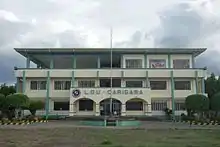
|
| |||||||||||||||||||||||||||||||||||||||||||||||||||
| Source: Philippine Statistics Authority [9][10][11][12] | ||||||||||||||||||||||||||||||||||||||||||||||||||||
In the 2020 census, the population of Carigara, Leyte, was 54,656 people,[3] with a density of 460 inhabitants per square kilometre or 1,200 inhabitants per square mile.
Language
The Waray-waray language is predominantly spoken within the municipality. Other recognized minority languages are Cebuano and Tagalog.
English is the language used in official purposes and often mixed in with Waray in casual conversations. Spanish is also present and/or used in very few purposes, but never in speech and communication.
Faith and Religion
Carigara is a Christian municipality, and most of the population are Roman Catholics. There are also adherents of other Christian denominations and sects like the Iglesia ni Cristo, the Church of Jesus Christ of Latter-day Saints, Seventh-day Adventists (Sabadistas), Evangelicals or Born Again Christians, Baptists, Jehovah's Witnesses (Mga Saksi ni Jehova) and some more.
Economy
Culture
Festival
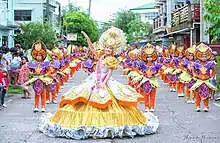
On January 25, 2019, Carigara had officially celebrated its first festival along with their 448th founding anniversary called the Magara Festival.[20] Magara locally means abundant, elegant, and vibrant. The first Magara Festival focuses mainly on the celebration of the abundance of the town's agriculture, local products, history, and its people.
Tourism
Here's a list of some tourist attractions of the municipality of Carigara.
Attractions include:
- Lauron's Boulevard (Brgy. Baybay & Ponong) This is the place where people can buy street foods like isaw, pork barbecues, and many more.
- Carigara Municipal Library and Museum (Brgy. Baybay)
- Cassidy Elementary School (Brgy. Ponong) A school famous for its classical-style building.
- Datu Gara Shrine (Brgy. Canal)
- Gawas an Harigue (Brgy. Baybay) An old house with exposed posts on the sides.
- Heroes Shrine (Brgy. Baybay & Ponong) Located right between Carigara Boulevard and the Kan Gara Gymnasium.
- Holy Cross Parish Church (Brgy. Ponong) The oldest and largest church in Carigara.
- Kan Gara Gymnasium (Brgy. Ponong) The largest gymnasium.
- Lumen Ancestral House (Brgy. Sawang) The only house in the town which serves as a shelter for balinsasayaos.
- Plaza Triunfo (Brgy. Ponong) The largest plaza.
- St. Francis Assisi Parish (Brgy. Jugaban)
Infrastructures
Land Transport
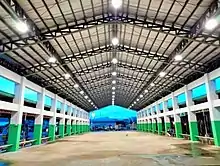
- Pedicabs are the common mode of transportation within the town proper and the poblacións.
- Tricycles and habal-habals on the other hand are commonly used for travelling within the town, especially to the far-flung barangays.
- Vans, jeepneys and buses are the mode of transport when travelling to the cities of Tacloban and Ormoc or to the municipalities that are faraway from the town. There are few bus companies situated in Carigara.
There are new modernized PUVs that travel from Carigara to Tacloban and vice versa issued by its local government on 24 November 2021.
Sea Transport

The municipality owns a port that is located in Barangay Baybay where local boats and ships docks.
Healthcare Service
Carigara District Hospital, also abbreviated as CDH is the only public hospital in the town. Other residents of nearby towns also come here to bring their ill patients for admission and further medical service attention.
Education
There are a total of 30 elementary schools, 6 high schools (1 Private, 4 Public, 1 pending construction) and 2 college institutions located on Carigara.[23]
Grade School/Elementary School
- Balilit Elementary School
- Barugohay Norte Elementary School
- Barugohay Sur Elementary School
- Binibihan Elementary School
- C.A.T.A.M.C.S. (Cong. Alberto T. Aguja Memorial Central School)
- Caghalo Elementary School
- Camansi Elementary School
- Candigahub Elementary School
- Canfabi ES (Santa Fe ES)
- Canlampay Elementary School
- Carigara II CS
- Cassidy Central School (Cassidy Elementary School)
- Cogon Elementary School
- Guindapunan Elementary School
- Hiluctogan Elementary School
- Hira-an Elementary School
- M. Morales Memorial Elementary School
- Macalpi Elementary School
- Manloy Elementary School
- Nauguisan Elementary School
- Pangna Elementary School
- Parag-um Elementary School
- Ponong Elementary School
- Sagkahan Elementary School
- Sogod Elementary School
- Santa Fe Elementary School
- Tagak Elementary School
- Tigbao Elementary School
- Tinaguban Elementary School
- Uyawan Elementary School
Secondary School/High School
- Carigara National High School
- Carigara National Vocational School (formerly Carigara School of Fisheries)
- Jugaban National High School
- Sogod National High School
- Holy Cross College of Carigara (Private)
- Parag-um National High School (soon)
College/University
- Holy Cross College of Carigara
- Eastern Visayas State University (Carigara Campus)
Notable personalities
- Eduardo Makabenta Sr. - Waray-language poet and translator[24]
- Mike Hanopol - musician, singer-songwriter
Gallery

| 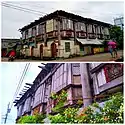
| 
|
| Century-old houses in Brgy. Jugaban, Carigara, Leyte | Gawas an Harigue | Carigara Municipal Library and Museum |
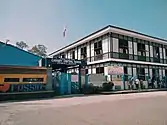
| 
| 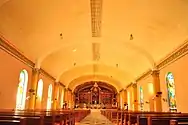
| 
|
| Cassidy Central School | Plaza Triunfo | Holy Cross Parish Church | Carigara Tide Embankment |
References
- Municipality of Carigara | (DILG)
- "2015 Census of Population, Report No. 3 – Population, Land Area, and Population Density" (PDF). Philippine Statistics Authority. Quezon City, Philippines. August 2016. ISSN 0117-1453. Archived (PDF) from the original on May 25, 2021. Retrieved July 16, 2021.
- Census of Population (2020). "Region VIII (Eastern Visayas)". Total Population by Province, City, Municipality and Barangay. Philippine Statistics Authority. Retrieved 8 July 2021.
- "PSA Releases the 2018 Municipal and City Level Poverty Estimates". Philippine Statistics Authority. 15 December 2021. Retrieved 22 January 2022.
- "Carigara Celebrates 446th Founding Anniversary". metrocarigarawd.gov.ph. 21 January 2017. Retrieved 3 December 2018.
- "Carigara attempts Guinness' largest participants in folk dance". sunstar.com.ph. 14 July 2018. Retrieved 28 November 2021.
- "Province:". PSGC Interactive. Quezon City, Philippines: Philippine Statistics Authority. Retrieved 12 November 2016.
- "Carigara: Average Temperatures and Rainfall". Meteoblue. Retrieved 9 February 2020.
- Census of Population (2015). "Region VIII (Eastern Visayas)". Total Population by Province, City, Municipality and Barangay. Philippine Statistics Authority. Retrieved 20 June 2016.
- Census of Population and Housing (2010). "Region VIII (Eastern Visayas)" (PDF). Total Population by Province, City, Municipality and Barangay. National Statistics Office. Retrieved 29 June 2016.
- Censuses of Population (1903–2007). "Region VIII (Eastern Visayas)". Table 1. Population Enumerated in Various Censuses by Province/Highly Urbanized City: 1903 to 2007. National Statistics Office.
- "Province of". Municipality Population Data. Local Water Utilities Administration Research Division. Retrieved 17 December 2016.
- "Poverty incidence (PI):". Philippine Statistics Authority. Retrieved December 28, 2020.
- "Estimation of Local Poverty in the Philippines" (PDF). Philippine Statistics Authority. 29 November 2005.
- "2003 City and Municipal Level Poverty Estimates" (PDF). Philippine Statistics Authority. 23 March 2009.
- "City and Municipal Level Poverty Estimates; 2006 and 2009" (PDF). Philippine Statistics Authority. 3 August 2012.
- "2012 Municipal and City Level Poverty Estimates" (PDF). Philippine Statistics Authority. 31 May 2016.
- "Municipal and City Level Small Area Poverty Estimates; 2009, 2012 and 2015". Philippine Statistics Authority. 10 July 2019.
- "PSA Releases the 2018 Municipal and City Level Poverty Estimates". Philippine Statistics Authority. 15 December 2021. Retrieved 22 January 2022.
- "Oldest town in Leyte holding first official festival". mb.com.ph. 24 January 2019. Retrieved 27 November 2021.
- "Leyte's animal jousts festival showcases delicacies". sunstar.com.ph. 29 March 2016. Retrieved 29 November 2021.
- ""No animal cruelty" in Turugpo". 27 March 2016. Retrieved 29 November 2021 – via PressReader.
- "Schools Directory | Trokis Philippines". School Torkis Directory. Archived from the original on October 30, 2018. Retrieved October 31, 2018.
- Sugbo, Victor, ed. (1995). Tinipigan: An Anthology of Waray Literature. Manila, Philippines: National Commission for Culture and the Arts. p. 271. OCLC 645852700. Retrieved 27 September 2019.